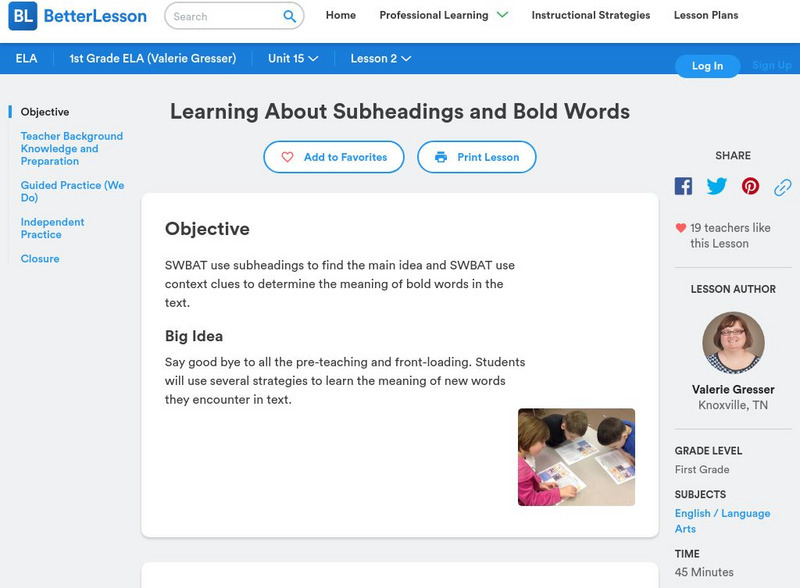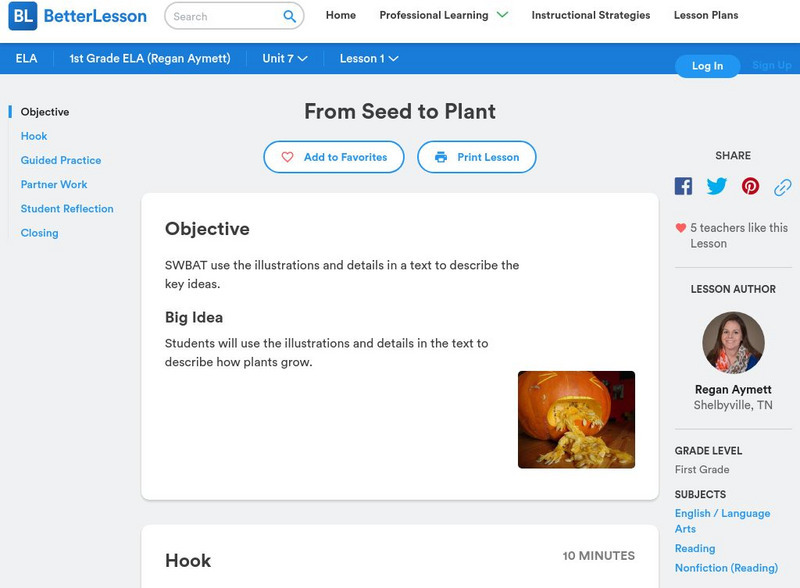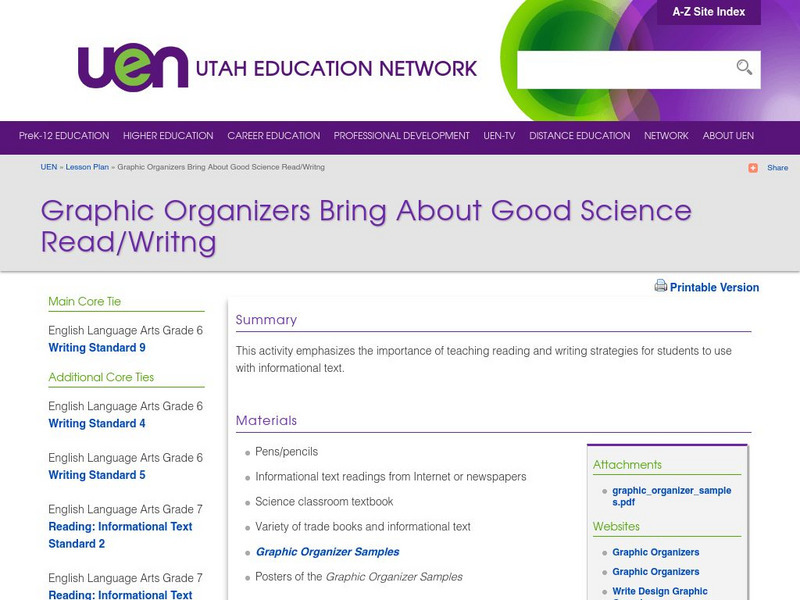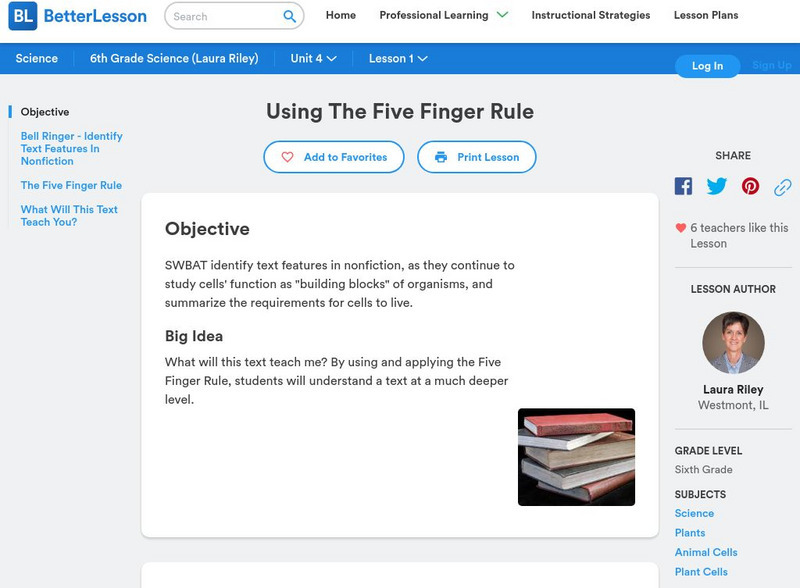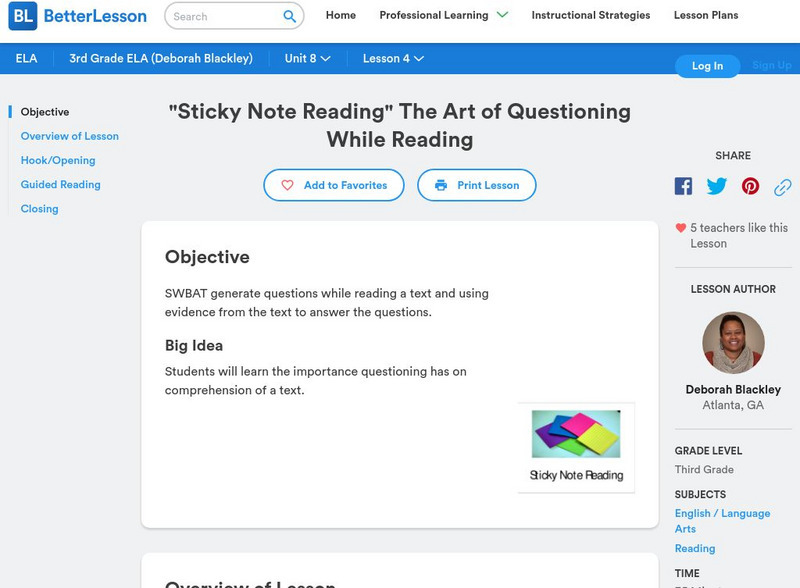College Board
Evaluating Sources: How Credible Are They?
How can learners evaluate research sources for authority, accuracy, and credibility? By completing readings, discussions, and graphic organizers, scholars learn how to properly evaluate sources to find credible information. Additionally,...
Better Lesson
Better Lesson: Audience, Tone, and Style in Informative Text
Students will read samples of informative writing and highlight examples of how tone and style are used by the authors. Students will then apply this knowledge by writing their own informative text. Multiple examples of student work and...
Texas Education Agency
Texas Gateway: Using Features of Literary & Informational Text to Guide Reading
A learning module that teaches students about using text features to guide reading in three mini lessons: Engaging with Text, Literary Think-Aloud, and Informational Think-Aloud. Download a PDF with lesson plans and printable handouts...
Other
Grade 1 Informative Writing Lessons
Authored by the Tsehai Russell and Della Wright, CLR fellows, this resource provides a 5-day unit of informative writing lessons. Focus lessons related to facts and opinions and paragraph writing. This series is supported by the Academic...
Better Lesson
Better Lesson: A Storm of Ideas
The first step in writing an informational text on the topic of learners' choice is helping the student choose a topic of interest. Students will brainstorm ideas that will be possible final topics.
Better Lesson
Better Lesson: Comparing and Contrasting With "Then and Now"
This lesson is a great small group reading lesson that has a social studies connection. In this lesson, students will be comparing and contrasting schools from long ago and schools of today using informational texts. Included are...
Better Lesson
Better Lesson: A Day to Celebrate Our Planet Earth
Students will compare an informational text versus a narrative text about Earth Day. Included in this lesson are videos and pictures of the lesson in action, a printable Earth Day Venn Diagram, and a recycling activity.
Better Lesson
Better Lesson: Cities in Mesopotamia: Understanding a Complex Text
In this instructional activity, 6th graders use details from a nonfiction article to create a visual representation and then, from that visual, provide evidence that demonstrates their understanding of the text. Includes samples of...
Better Lesson
Better Lesson: Similarities and Differences Between Two Text
In this lesson, through guided practice, the students use two texts about Martin Luther King to compare the similarities and differences between those texts. Includes videos of the lesson in action, printable charts, and a graphic...
Better Lesson
Better Lesson: Learning About Subheadings and Bold Words
In this lesson plan, students will use several strategies to learn the meaning of new words they encounter in text. The students will learn specific strategies so when they encounter new words, they can figure out the meaning of those...
Better Lesson
Better Lesson: From Seed to Plant
Students will use the illustrations and details in the text to describe how plants grow. This lesson uses a complex text to allow students to analyze the pictures in From Seed to Plant and From Seed to Pumpkin. Included are videos and...
Utah Education Network
Uen: Newspaper Lesson Plan
This lesson plan engages students developing a newspaper. Students will demonstrate their understanding of the term "revolution" as they create their newspaper.
Other
Pde: Sas: Identifying and Understanding Use of Testimonials in Advertising
In this lesson, 8th graders analyze and compare the propaganda techniques used in informational texts, with a particular focus on the use of testimonials. Includes links to recommended resources, scaffolding suggestions, and an...
Better Lesson
Better Lesson: The 2 Faces of Pocahontas
Teachers will engage young learners to understand how one story can be shared more than one way. This lesson demonstrates an historical interpretation of the story about Pocahontas and John Smith with the Disney movie. Several resources...
Utah Education Network
Uen: Graphic Organizers Bring About Good Science Read/writing
This lesson uses graphic organizers to engage students in reading comprehension strategies for informational text in science. Venn Diagram, Hierarchy, Time Line, Cluster Diagram, and Flow Chart reproducible pages are included with the...
ReadWriteThink
Read Write Think: Listen, Look, and Learn: An Information Gathering Process
This instructional activity models an information-gathering process for primary learners as they listen to and look at resources, seeking information pertinent to the questions on an information wheel. Guiding the listening, looking, and...
Education.com
Education.com: ri.k.9 Lesson Plans
[Free Registration/Login Required] These lesson plans can help young scholars practice identifying basic similarities in and differences between two texts on the same topic.
Better Lesson
Better Lesson: Using the Five Finger Rule
Students identify text features in nonfiction, as they continue to study cells' function as building blocks of organisms, and summarize the requirements for cells to live.
Read Works
Read Works: Organizing Information Into an Outline
[Free Registration/Login Required] In this activity, students will take notes as they read Animal Homes by Ann O. Squire. This information will then be organized into an outline. Includes printable materials for teacher and students.
Better Lesson
Better Lesson: Pumpkins and Apples, Oh My!
Students will be able to compare and contrast two non-fiction books with a similar theme - in this case, plant life cycles. Extensive resources included such as worksheets, samples of student work, assessment ideas, extension activities,...
Khan Academy
Khan Academy: Organizing Information Quick Guide
Organizing information questions ask you to understand and analyze how a passage works to make an argument. What is the progression of ideas in the passage? or What is the purpose of a specific paragraph?
Other
Sas: Exploring Ways Authors Use Text Structures to Convey Meaning
In this lesson, young scholars will explore ways authors use text structures to convey meaning through cause and effect, sequencing, comparison, and more.
CPALMS
Cpalms: It's All in the Details
Using this comprehensive lesson plan, students will use a web graphic organizer to learn to record the main idea and details learned from informational text read aloud to them.
Better Lesson
Better Lesson: "Sticky Note Reading" the Art of Questioning While Reading
Third graders will learn the importance questioning has on comprehension of a text. Students will use sticky notes and an interactive reading notebook while working with an informational text.









